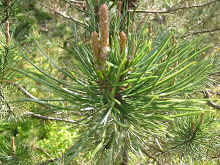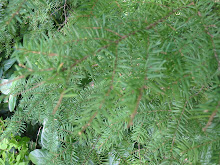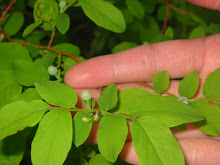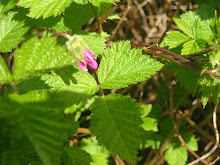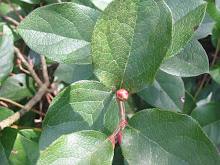These fungi are called bird's nest fungi. As you can see, they look like nests made by little tiny birds with several little eggs inside. The scientific name of this one is Nidula candida. They grow on twigs on the ground. The scientific name for an 'egg' is a peridiole. Inside each peridiole is thousands of spores. The spores get dispersed by having the eggs fly out when water splashes into the cup. Thanks for the pictures Gerry!
Friday, November 30, 2012
Bird's Nest Fungi
It's that time of the year again. That time when the leaves fall off the trees, the temperature drops, and it rains, rains, rains. All these things make the perfect conditions for fungi to grow. You know, those creatures that are not quite plant, and not quite animal, that do an amazing job at decay. They are around us everywhere: in the soil, in the air, and in the water. Only when they fruit, do we get to see the diversity of their forms. Gerry found one in the bog the other day.
These fungi are called bird's nest fungi. As you can see, they look like nests made by little tiny birds with several little eggs inside. The scientific name of this one is Nidula candida. They grow on twigs on the ground. The scientific name for an 'egg' is a peridiole. Inside each peridiole is thousands of spores. The spores get dispersed by having the eggs fly out when water splashes into the cup. Thanks for the pictures Gerry!
These fungi are called bird's nest fungi. As you can see, they look like nests made by little tiny birds with several little eggs inside. The scientific name of this one is Nidula candida. They grow on twigs on the ground. The scientific name for an 'egg' is a peridiole. Inside each peridiole is thousands of spores. The spores get dispersed by having the eggs fly out when water splashes into the cup. Thanks for the pictures Gerry!
Friday, November 23, 2012
Name That Fungus
Hi Crazy Boggers:
It looks like the weather is going to cooperate for Saturday. We may even get a little sunshine!
The water level is even higher than it was two weeks ago. That is good for the bog but more difficult for us to get into many areas. We will continue to remove patches of polytrichum and lower areas in preparation for planting and there is always weeding to be done.
The attached pictures of the Lipstick Cladonia Lichen were taken at the foot of the Saskatoon Berry Tree last week. Who can name the growth in front of the lichen?
See you all on Saturday.
Gerry
Friday, November 16, 2012
 |
| Misty bog |
Thanks to the representatives from ECHO and the family from Emily Carr U. who joined our work party. I believe it is the first time we had 6 year old twins girls volunteering. They did a great job of separating the sphagnum mosses from the polytrichum.
Unfortunately the weatherman does not want to cooperate this coming Saturday but hopefully the weather will be better the following Saturday.
Laurence sent me the attached great photos taken early Thursday morning with the following caption:
" Many of the trees and bushes were covered by spider webs. These were covered by dew drops and glistened as the sun beams shone through the mist. What a beautiful place!"
See you all next week.
Gerry
 |
| spider web on blueberry |
Thursday, November 15, 2012
Friday, October 26, 2012
Bald Eagle perching on Shore Pine
Gerry observed and photographed yet another raptor in the bog:
We had another successful work party this past Saturday with 15 volunteers in attendance. We collected mosses from the forest and planted a large section to the east of the platform.
We collected more moss during the week in hopes that the weather will cooperate for another week and we will have time to plant remaining areas.
While I was in the bog this past Sunday I look up as there was a number of crows making a lot of noise.This is a usual sign an intruder is in their area and sure enough the Bald Eagle had landed some 50-60 ft. from where I was standing. He then proceeded to move to the dead shore pine.
The eastern Blue Jay that all the birders we looking for didn't show up in the bog but our Bald Eagle paid us a visit. Enjoy!
See you all on Saturday.
Gerry
 |
| Bald Eagle in Pinus contorta |
Thursday, October 18, 2012
Looks Like Frog Pelt Lichen
 Last Saturdays work party of 8 used up all the sphagnum mosses we had collected from the forest. It was used to plant two fairly big areas of the bog that we had been prepping for some time. We planted it just in time as the subsequent rains flooded the area. This Saturday we will have to look for areas dry enough to work.
I thought I would share with the group some of the pictures I have taken of plants, other than sphagnum mosses, that also grow in the bog. Attached are pictures of a Lichen called Frog Pelt that is presently growing in the bog. Pojar states that it comes in 3 different colors: olive green, milky blue and dark slate blue. It has brownish, tooth like fruiting bodies (#9578) on raised lobes. The lower surface is whitish with long slender holdfasts called rhizines (# 7325). This lichen is located on a covered stump close to the "sphagnum mosses" sign just in front of the bench on the south side of the bog. -- Gerry
Last Saturdays work party of 8 used up all the sphagnum mosses we had collected from the forest. It was used to plant two fairly big areas of the bog that we had been prepping for some time. We planted it just in time as the subsequent rains flooded the area. This Saturday we will have to look for areas dry enough to work.
I thought I would share with the group some of the pictures I have taken of plants, other than sphagnum mosses, that also grow in the bog. Attached are pictures of a Lichen called Frog Pelt that is presently growing in the bog. Pojar states that it comes in 3 different colors: olive green, milky blue and dark slate blue. It has brownish, tooth like fruiting bodies (#9578) on raised lobes. The lower surface is whitish with long slender holdfasts called rhizines (# 7325). This lichen is located on a covered stump close to the "sphagnum mosses" sign just in front of the bench on the south side of the bog. -- GerryFriday, September 14, 2012
Barred owl watches over our work party
"...As you can see from the attached photos, we had a wise old owl watching our every move. It was perched in a hemlock tree just at the 21st Ave. entrance. In the first photo he seems to be giving us " the sign of approval for a job well done."
We will continue with the weeding, removal of the polytrichum and lowering of the bog surface in preparation for planting"
--Gerry
Friday, September 7, 2012
Where the Wild Things Are Teacher Pro-D, Oct 19, 2012
that very night in Max's room a forest grew, and grew, until the ceiling hung with vines, and the walls became the world around...",
- Maurice Sendak, Where the Wild Things Are.
Bog Buddy program, 2011. photo credit: Marian De Geer,
Biology 11 students teach elementary students in Camosun bog: photo credit: Marian De Geer
When: October 19, 2012 9:30 - 12:30 pm
Where to meet: Entrance of Camosun Bog (map)
Who can register: youth leaders, urbanists, teachers, informal educators, student teachers. Register by contacting Susan at codesignyouthmanual@gmail.com
(If you are a teacher, please let us know if you are secondary or elementary).
Cost: free
Presenters: VSB teachers, The Camosun Bog Restoration Group, Metro Vancouver Regional Parks interpreters, and Co-Design Group
Dress code, what to bring:
|
This is an outdoor program happening rain or shine. Be prepared for rain. Bring your favourite tea mug.
Join the Crazy Boggers, Metro Vancouver Regional Park interpreters and VSB teachers for an active and informative Pro-D walking through an enchanting urban bog! Learn the fascinating story of this ancient ecosystem and methods for interpreting the bog for students of all ages. Taste Labrador Tea, touch a carnivorous sundew and Jump on a bog trampoline! Walk away with lesson strategies, classroom resources and the ability to identify at least five bog species and five invasive species, guaranteed!
Purpose of this workshop:
- To give educators the tools to bring their classrooms and small groups to the bog with confidence
- To familiarize educators with the bog narrative, bog ecology and share connections to the elementary and secondary curriculum.
- To encourage educators to visit our bog. Camosun bog is the most transit - accessible bog in Vancouver and we encourage everyone to experience this treasure in the city
Our presenters have experience interpreting the bog for elementary students and secondary students up to senior secondary. Furthermore, the metro vancouver regional parks interpreters are well versed in presenting the bog in an informal context. The bog is a great outdoor classroom for the following topics:
plant anatomy
ecological succession
bog ecology
bryophytes
plant competition
urban geography
local history of our city
and it is a wonderful location for inspiring students to create art, poetry, short stories.
Saturday, June 16, 2012
The Life Cycle of a Sphagnum Moss
When one works with Sphagnum moss, its good to know how it grows and reproduces. Mosses have different life cycles than plants or animals, that most people are completely unaware of. They have an "alternation of generations" which means the haploid (N) and diploid (2N) stages of life are multicellular and long lived. The 'ploidy' relates to how many sets of chromosomes you have. If you are 2N, you have one set of chromosomes from your mother, and one set of chromosomes from your father. If you are N, you only contain one set of chromosomes, either from your mother or from your father. Lets start the life cycle with a spore.
Labels:
life cycle,
sphagnum
Monday, June 4, 2012
Monday, April 2, 2012
sundews are back!
Drosera rotundifolia unfurls its sticky tendrils to get ready for this year's mosquito season. Does it look hungry? It's only the diameter of a Canadian Loonie (one dollar coin) at the moment. Eventually it will get to the size below: (picture below from 2010) Kids who visit the bog love to observe this carnivore in action.
Saturday, March 31, 2012
March 24 Planting Party at Stanley Park Bog
We were very lucky to have a bright sunny day when we assisted the Stanley Park Ecology Society in planting the large area that had been cleared and levelled. We were able to complete the entire area and in the process used no less than 24 baskets of sphagnum. We were delighted to have Loretta Woodcock join us as funding for this project was due to her efforts with the Vancouver Parks Board. (thanks to Susan and Loretta for the photos)
 |
| Loretta Woodcock with Laurence |
.
Friday, March 16, 2012
Bog Buddies wrote poems! Read about it in BC Green Games
Last year, local biology students led a a tour of the bog for elementary students. In response, Ms. Cultum , the teacher of the elementary students led her class to write responsive poetry. A sample is published below. A description of this project was summarized recently by the biology students in their BC green games entry. BC Green Games is an inspiring gallery of the scope of sustainability projects led by youth in BC schools.
http://www.bcgreengames.ca/component/project/?id=593
Saturday, March 10, 2012
Fairy Puke
If you go to the back of the bog, to the area that was cleared in the early 2000's, which is now covered in mounds and hillocks of sphagnum moss, you will see a most interesting organism. It looks like greenish-grey dust covered in pink spots. It's common name, I kid you not, is Fairy Puke.
The scientific name is Icmadophila ericetorum. Fairy Puke grows on rotting logs and stumps. It is a lichen. What is a lichen you say? A lichen is a fungus that has discovered agriculture. The fungus provides a habitat for a photosynthetic algae to grow, and in return, the fungus receives sugars from the algae so it can grow and reproduce.
The body of the lichen is blue-green because of the colour of the algae. The pink structures are the reproductive structures of the fungus, called apothecia. They are somewhat cup-shaped and spores are produced and released from these structures. So now you can say you've seen Fairy Puke!
The scientific name is Icmadophila ericetorum. Fairy Puke grows on rotting logs and stumps. It is a lichen. What is a lichen you say? A lichen is a fungus that has discovered agriculture. The fungus provides a habitat for a photosynthetic algae to grow, and in return, the fungus receives sugars from the algae so it can grow and reproduce.
 |
| From http://herbarium.usu.edu/fungi/funfacts/lichens.htm |
Friday, March 9, 2012
Raring to go!
Work parties have started every saturday at the bog! All intrepid boggers aged 16 and up are welcome to help out at Camosun bog: dress in layers, rain boots, and be prepared to be covered in peat.
Hi Crazy Boggers:
Hi Crazy Boggers:
I hope everyone had a good week and are just raring to get back to the bog. We will continue the heavy slogging removing salal roots, trimming around the blueberry bushes, digging them up and finding a new home for them in the area we have been clearing.
Looks like we will be accompanied by wet weather but with any luck maybe the weatherman will be wrong.
Thursday, March 8, 2012
Earthmaker's Art Project
The Camosun bog Restoration Group and Co-design Group will be engaging the Killarney Community to envision the ghost of a bog that once thrived in this neighbourhood. And artist Pat Beaton, organizer of Earthmakers, will then lead a community art project where participants create prints for a community mural. For details on this free event, click on the picture :
Laurence Brown did some preliminary research on Killarney bog and, by examining some fascinating archival maps, this is what he discovered:
Most of our knowledge about the Killarney bog comes from surveys of the Fraser River lowlands carried out by the Royal Engineers between 1858 and 1880. These observations are consolidated in a map drawn up by North, Dunn and Teversham. The portion adjacent to the Killarney bog is shown below
The surveyors reported the central area as having organic soil. This would be either peat from sphagnum moss or partially decomposed sedges and rushes. The surface vegetation was reported as Labrador tea and cranberry. The surveyors called this a marsh but we would call it either a bog or a fen. The area round the bog was covered with grass. There is some possibility that this area was burnt by First Nations in order to improve the cranberry crop.
The area forms a bowl with lower areas trending north from the east and west edges. These form two of the headwaters of Still Creek (see “Lost Streams of the Lower Fraser Valley” published by DFO). It seems likely that the original bog occupied the area roughly below the 94m contour.
I have combined the two maps below
The match is not particularly good but given that there has been 150 years between the two surveys and a lot has happened in this time it is not too surprising.
Interestingly, a quick survey of the area showed a construction site (see red dot in map above) with indications of some peat in the excavation
Laurence Brown
June 6, 2011
Monday, February 20, 2012
Susan Point and Rose Point talk about their traditional territory
Camosun bog is part of the traditional territory of the Musqueam people.
Saturday, January 28, 2012
Sphagnum Under the Microscope
As part of a bryology course at the University of British Columbia, I looked at some of the sphagnum mosses in Camosun Bog. I'd like to show you one of the mosses, Sphagnum palustre, magnified up close. This is what is looks like fresh.
If I were to pull out one individual and dry it, this is what it would look like:
Its hard to see, but there are two kind of "leaves" on this moss, ones that go down the stem and ones that come off on horizontal branches.
This is what a divergent leaf looks like under the microscope. In this case, there are holes where water can enter the cell.
Now if we did a cross-section of the leaf, what would it look like?
The leaf is only one cell thick! Here you can really see how photosynthetic cells are squeezed between transparent cells. Next is a cross-section of the stem.
The big clear cells are designed to store water. The closely packed cells in the middle are designed to move water from the bottom of the plant, to the top. There are no photosynthetic cells. Some sphagnums in the bog can be identified by the eye, like the bright red S. capillifolium, while others require comparing structures under the microscope, like I've just shown. Sphagnum is very pretty both to the naked eye, as well as under a microscope.
If I were to pull out one individual and dry it, this is what it would look like:
Its hard to see, but there are two kind of "leaves" on this moss, ones that go down the stem and ones that come off on horizontal branches.
From Crum, Howard. 1984. North American Flora. Series II. Part 11. Sphagnopsida. Sphagnaceae. Published by the New York Botanical Garden, Bronx, NY.
This is what a stem leaf looks like and what the stem leaf cells look like:
There are two types of cells. One type is green and undergoes photosynthesis. The other type is clear and allows the plant to take up water as a storage reservoir.This is what a divergent leaf looks like under the microscope. In this case, there are holes where water can enter the cell.
Now if we did a cross-section of the leaf, what would it look like?
The leaf is only one cell thick! Here you can really see how photosynthetic cells are squeezed between transparent cells. Next is a cross-section of the stem.
The big clear cells are designed to store water. The closely packed cells in the middle are designed to move water from the bottom of the plant, to the top. There are no photosynthetic cells. Some sphagnums in the bog can be identified by the eye, like the bright red S. capillifolium, while others require comparing structures under the microscope, like I've just shown. Sphagnum is very pretty both to the naked eye, as well as under a microscope.
Labels:
sphagnum,
sphagnum moss
Subscribe to:
Comments (Atom)




















































